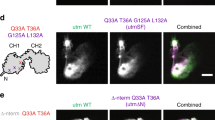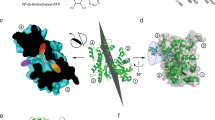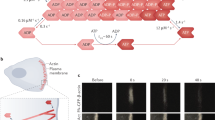Abstract
Actin filament dynamics are critical in cell motility1,2. The structure of actin filament changes spontaneously and can also be regulated by actin-binding proteins, allowing actin to readily function in response to external stimuli1. The interaction with the motor protein myosin changes the dynamic nature of actin filaments3,4. However, the molecular bases for the dynamic processes of actin filaments are not well understood. Here, we observed the dynamics of rabbit skeletal-muscle actin conformation by monitoring individual molecules in the actin filaments using single-molecule fluorescence resonance energy transfer (FRET)5,6,7 imaging with total internal reflection fluorescence microscopy (TIRFM)8. The time trajectories of FRET show that actin switches between low- and high-FRET efficiency states on a timescale of seconds. If actin filaments are chemically cross-linked, a state that inhibits myosin motility9, the equilibrium shifts to the low-FRET conformation, whereas when the actin filament is interacting with myosin, the high-FRET conformation is favored. This dynamic equilibrium suggests that actin can switch between active and inactive conformations in response to external signals.
This is a preview of subscription content, access via your institution
Access options
Subscribe to this journal
Receive 12 print issues and online access
$259.00 per year
only $21.58 per issue
Buy this article
- Purchase on Springer Link
- Instant access to full article PDF
Prices may be subject to local taxes which are calculated during checkout



Similar content being viewed by others
References
Rafelski, S.M. & Theriot, J.A. Crawling toward a unified model of cell mobility: spatial and temporal regulation of actin dynamics. Annu. Rev. Biochem. 73, 209–239 (2004).
Pollard, T.D., Blanchoin, L. & Mullins, R.D. Molecular mechanisms controlling actin filament dynamics in nonmuscle cells. Annu. Rev. Biophys. Biomol. Struct. 29, 545–576 (2000).
Yanagida, T., Nakase, M., Nishiyama, K. & Oosawa, F. Direct observation of motion of single F-actin filaments in the presence of myosin. Nature 307, 58–60 (1984).
Humphrey, D., Duggan, C., Saha, D., Smith, D. & Kas, J. Active fluidization of polymer networks through molecular motors. Nature 416, 413–416 (2002).
Weiss, S. Fluorescence spectroscopy of single biomolecules. Science 283, 1676–1683 (1999).
Ishii, Y., Yoshida, T., Funatsu, T., Wazawa, T. & Yanagida, T. Fluorescence resonance energy transfer between single fluorophores attached to a coiled-coil protein in aqueous solution. Chem. Phys. 247, 163–173 (1999).
Ha, T. et al. Initiation and re-initiation of DNA unwinding by the Escherichia coli Rep helicase. Nature 419, 638–641 (2002).
Funatsu, T., Harada, Y., Tokunaga, M., Saito, K. & Yanagida, T. Imaging of single fluorescent molecules and individual ATP turnovers by single myosin molecules in aqueous solution. Nature 374, 555–559 (1995).
Prochniewicz, E. & Yanagida, T. Inhibition of sliding movement of F-actin by crosslinking emphasizes the role of actin structure in the mechanism of motility. J. Mol. Biol. 216, 761–772 (1990).
Moens, P.D., Yee, D.J. & dos Remedios, C.G. Determination of the radial coordinate of Cys-374 in F-actin using fluorescence resonance energy transfer spectroscopy: effect of phalloidin on polymer assembly. Biochemistry 33, 13102–13108 (1994).
Mermall, V., Post, P.L. & Mooseker, M.S. Unconventional myosins in cell movement, membrane traffic, and signal transduction. Science 279, 527–533 (1998).
Otterbein, L.R., Graceffa, P. & Dominguez, R. The crystal structure of uncomplexed actin in the ADP state. Science 293, 708–711 (2001).
Galkin, V.E., VanLoock, M.S., Orlova, A. & Egelman, E.H. A new internal mode in F-actin helps explain the remarkable evolutionary conservation of actin's sequence and structure. Curr. Biol. 12, 570–575 (2002).
Orlova, A. & Egelman, E.H. Structural dynamics of F-actin: I. Changes in the C terminus. J. Mol. Biol. 245, 582–597 (1995).
Moens, P.D. & dos Remedios, C.G. A conformational change in F-actin when myosin binds: fluorescence resonance energy transfer detects an increase in the radial coordinate of Cys-374. Biochemistry 36, 7353–7360 (1997).
McGough, A., Pope, B., Chiu, W. & Weeds, A. Cofilin changes the twist of F-actin: implications for actin filament dynamics and cellular function. J. Cell Biol. 138, 771–781 (1997).
Egelman, E.H., Francis, N. & DeRosier, D.J. F-actin is a helix with a random variable twist. Nature 298, 131–135 (1982).
Schmid, M.F., Sherman, M.B., Matsudaira, P. & Chiu, W. Structure of the acrosomal bundle. Nature 431, 104–107 (2004).
Ng, C.M. & Ludescher, R.D. Microsecond rotational dynamics of F-actin in ActoS1 filaments during ATP hydrolysis. Biochemistry 33, 9098–9104 (1994).
Harada, Y., Sakurada, K., Aoki, T., Thomas, D.D. & Yanagida, T. Mechanochemical coupling in actomyosin energy transduction studied by in vitro movement assay. J. Mol. Biol. 216, 49–68 (1990).
James, L.C. & Tawfik, D.S. Conformational diversity and protein evolution–a 60-year-old hypothesis revisited. Trends. Biochem. Sci. 28, 361–368 (2003).
Ito, Y. et al. Regional polysterism in the GTP-bound form of the human c-Ha-Ras protein. Biochemistry 36, 9109–9119 (1997).
Eisenmesser, E.Z. et al. Intrinsic dynamics of an enzyme underlies catalysis. Nature 438, 117–121 (2005).
Kirschner, M., Gerhart, J. & Mitchison, T. Molecular “vitalism”. Cell 100, 79–88 (2000).
Takashi, R. A novel actin label: a fluorescent probe at glutamine-41 and its consequences. Biochemistry 27, 938–943 (1988).
Homma, K., Yoshimura, M., Saito, J., Ikebe, R. & Ikebe, M. The core of the motor domain determines the direction of myosin movement. Nature 412, 831–834 (2001).
Kabsch, W., Mannherz, H.G., Suck, D., Pai, E.F. & Holmes, K.C. Atomic structure of the actin:DNase I complex. Nature 347, 37–44 (1990).
Mendelson, R. & Morris, E.P. The structure of the acto-myosin subfragment 1 complex: results of searches using data from electron microscopy and x-ray crystallography. PNAS 94, 8533–8538 (1997).
Acknowledgements
We thank A.H. Iwane and T. Wazawa for technical support and P. Karagiannis, J. West and M. Zulliger for revising the manuscript.
Author information
Authors and Affiliations
Corresponding author
Ethics declarations
Competing interests
The authors declare no competing financial interests.
Supplementary information
Supplementary Fig. 1
Single-molecule FRET microscopy (PDF 506 kb)
Supplementary Fig. 2
Power spectrum densities of the fluctuation of the fluorescence intensities and FRET efficiency. (PDF 161 kb)
Supplementary Fig. 3
Evaluation of observed FRET signals using correlation factors. (PDF 144 kb)
Supplementary Fig. 4
The effect of myosin-V in the absence of ATP on the FRET efficiency distribution. (PDF 268 kb)
Supplementary Fig. 5
Kinetic analysis for the transition between two actin conformational states. (PDF 199 kb)
Supplementary Fig. 6
Orthogonally polarized florescence measurement. (PDF 1931 kb)
Rights and permissions
About this article
Cite this article
Kozuka, J., Yokota, H., Arai, Y. et al. Dynamic polymorphism of single actin molecules in the actin filament. Nat Chem Biol 2, 83–86 (2006). https://doi.org/10.1038/nchembio763
Received:
Accepted:
Published:
Issue Date:
DOI: https://doi.org/10.1038/nchembio763
This article is cited by
-
Flagella-like beating of actin bundles driven by self-organized myosin waves
Nature Physics (2022)
-
Single molecule turnover of fluorescent ATP by myosin and actomyosin unveil elusive enzymatic mechanisms
Communications Biology (2021)
-
Biased localization of actin binding proteins by actin filament conformation
Nature Communications (2020)
-
Single-molecule fluorescence-based analysis of protein conformation, interaction, and oligomerization in cellular systems
Biophysical Reviews (2018)
-
Prism-based Spectral Imaging of Four Species of Single-molecule Fluorophores by Using One Excitation Laser
Journal of Fluorescence (2013)



